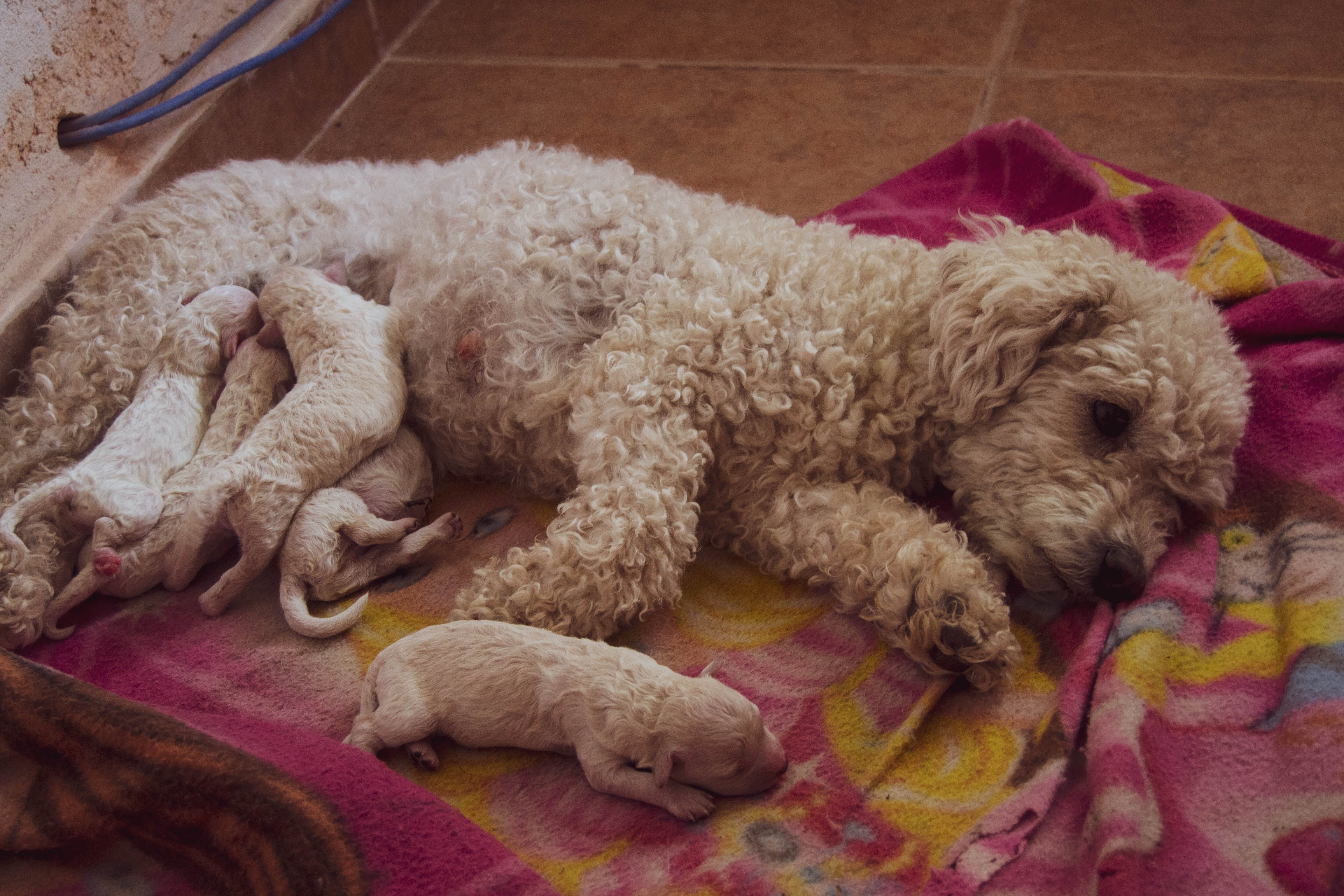Disclaimer: Please refer to the information in this article as a guide only. If you are worried about your pet’s health or behavior, it’s best to contact your veterinarian.
Are you concerned about the health of your nursing dog? Mastitis – a common yet often overlooked condition, poses significant risks to lactating canines. But what exactly is mastitis in dogs & how can it impact your furry friend’s health and well-being?
- Mastitis in dogs is inflammation of mammary glands, often from infections.
- Treatments range from antibiotics to surgery based on severity.
- Preventive measures include clean living areas and regular vet check-ups.
- Early detection and treatment adherence are key to recovery.
Mastitis is mammary gland inflammation in dogs, often due to bacterial or fungal infections, and manifests as acute, septic, chronic, or gangrenous. Symptoms start with swollen glands and poor puppy growth, leading to ulceration. Treatment varies, from antibiotics to surgery, depending on severity.
There is a lot to talk about mastitis. Let’s understand the causes, symptoms, and treatment options for mastitis in dogs in this article in detail, ensuring the health and well-being of your beloved pet.
The information provided herein is for informational purposes only. Please refer to our disclaimer for more details..
What is Mastitis in Dogs?
Image credits: Briseed ~
In dogs, mastitis means their mammary glands are inflamed. This usually happens in nursing female dogs but, it can affect any breed or age. Most often – it’s nursing mothers who get it. The inflammation usually comes from bacterial or fungal infections.
Types of Mastitis
Let’s look at the different types of Mastitis in dogs. Each type has its own features:
- Acute Mastitis: This condition involves significant swelling of the mammary glands, causing pain. It may lead to the mother dog avoiding nursing her pup and exhibiting signs of lethargy.
- Septic Mastitis: This type causes the mammary glands to be warm and painful. The milk may change color, and the mother dog can become ill.
- Non-septic Mastitis: This involves inflammation of the mammary glands not linked to a bacterial infection.
- Chronic Mastitis: This is a long-term swelling of the mammary glands and it’s not as easy to notice because it doesn’t show the same symptoms as the other types.
- Gangrenous Mastitis: This is a serious form. And the teat turns black and the nearby belly area might also darken. The mother dog may show signs of being ill.
Causes of Mastitis in Dogs
Image credits: SandeepHanda
When looking into why mastitis happens – it’s important to know that it doesn’t just come out of nowhere. Many things can lead to it:
- Bacterial & Fungal Infections: These are often the main cause. They can get in through injuries to the mammary gland or teat canal. The following list of fungi & bacteria are mostly responsible for this condition:
- Mycobacterium
- Blastomycosis
- Staphylococcus
- Escherichia coli
- Enterococci
- And Streptococcus.
- Nursing Dogs: It’s not only cuts and wounds that let in infections, nursing itself can cause problems. If puppies scratch their mom’s skin, they might accidentally bring in harmful germs.
- Mammary Gland Cancer: Sometimes, mastitis in dogs that aren’t nursing, including males, comes from mammary gland cancer.
- Unsanitary Living Conditions: Moreover, unsanitary living conditions can exacerbate the risk, turning a nurturing environment into a breeding ground for bacteria.
- Breed Predispositions: Some dog breeds are more likely to get mastitis because of their genetics.
- Previous History of Mastitis: If a dog has had mastitis before, there’s a higher chance it will happen again.
Some dogs are more at risk of getting mastitis, such as:
- Dogs with Larger Litters: More puppies can mean more pressure on the mammary glands.
- Sudden Weaning or Death of a Puppy: If this happens, milk can build up in the glands, raising the risk of mastitis.
Clinical Signs of Mastitis
Navigating the complexities of mastitis in dogs requires a keen eye for symptoms. This condition, often overlooked, can escalate from subtle signs to severe health issues – making early detection crucial.
Early Signs
The first symptoms of mastitis in dogs can be easy to miss. They’re often mild. Key early signs are:
- Puppies Not Gaining Weight: This might be the first sign. If puppies aren’t growing right, it could be because they’re not getting enough milk due to mastitis.
- Slight Swelling or Inflammation of Mammary Glands: A careful examination might reveal subtle changes in the mammary glands, such as mild swelling or redness, indicating the onset of mastitis.
Advanced Symptoms
As mastitis gets worse, the symptoms become clearer and more worrying:
- Swollen, Inflamed, Discolored Teats: The affected mammary glands may become significantly swollen, and tender, and change color, often turning red or purple.
- Ulceration and Open Wounds: In bad cases, the skin over the glands can ulcerate, leading to wounds and scabs.
- Presence of Blood or Pus in Milk: The milk might have blood or pus in it. And it can look cloudy or thick.
- Vomiting: If the infection gets into the bloodstream, the dog may experience vomiting because of the toxins from the bacteria.
- Systemic Infection and Sepsis: If the infection spreads, it can cause sepsis. This is a very serious reaction to infection and can be life-threatening.
In addition to these, your dog may also experience fever, dehydration, weight loss, lethargy, and restlessness.
Mastitis Diagnosis Methods
In numerous instances, mastitis can be identified through a physical assessment of signs. And, on occasion, your veterinarian might suggest laboratory examinations to validate the diagnosis or eliminate alternative conditions.
- Milk Cytology: A sample of milk from the affected gland is examined under a microscope and the presence of white blood cells or bacteria confirms mastitis.
- Complete Blood Cell Count (CBC): This test assesses the levels of various blood cells. An elevated white blood cell count can indicate severe infection while platelet abnormalities can indicate sepsis & gangrenous mastitis.
- Bacterial Culture: In cases where mastitis is not responding to standard treatments, a bacterial culture may be necessary. And, this involves collecting milk in a sterile manner for laboratory analysis to identify the specific bacteria causing the infection and determine the most effective antibiotics for treatment.
- Ultrasound and Thyroid Profile: Your veterinarian may suggest an ultrasound for the affected teat to identify abscesses or tumors. Additionally – a thyroid profile may be conducted to exclude hypothyroidism as a possibility.
Treatment of Mastitis In Dogs
When it comes to the treatment of mastitis in dogs, the approach varies based on the severity of the condition.
Outpatient Treatment
For mild cases of mastitis – your vet may recommend outpatient treatment so that the dog can stay with puppies and this includes:
- Oral Antibiotics and Pain Medication: These are prescribed to combat the infection & alleviate discomfort such as Cephalexin, Clavamox, or nonsteroidal anti-inflammatory drugs.
- Hand-Milking the Infected Gland: Your vet may recommend this method to help relieve pressure in the mammary gland, flush out bacteria, encourage blood flow, and promote healing. And it should be done gently every 6 hours.
- Cabbage Leaf Compresses: An unconventional yet effective method, your vet may ask you to apply cabbage leaves to the affected area to reduce swelling and pain. They should be changed every few hours for maximum effectiveness.
Hospitalization and Surgery
In more severe cases, hospitalization might be necessary, involving:
- Intravenous Fluid Therapy and Injectable Medications: These are administered to manage severe infections and provide supportive care.
- Surgical Removal of Severely Infected Glands: In extreme cases where the infection has caused significant tissue damage – surgical intervention may be required to remove the affected mammary glands.
Important Note: It’s crucial to refrain from allowing to nurse puppies until your vet approves. Because infection and medications can pass through the milk to the puppies, posing significant risks.
Prevention Strategies
Preventing mastitis is key to avoiding the distress it causes to both dogs and their owners. Here are some effective prevention strategies:
Sanitary Measures
- Keeping the Living Area Clean: A clean environment reduces the risk of bacterial infections.
- Regular Baths for Lactating Dogs: This helps maintain hygiene and it also prevents the buildup of bacteria around the mammary glands.
Other Precautions
- Clipping Puppies’ Nails: This prevents scratches on the mother’s mammary glands during nursing.
- Monitoring for Early Signs: Regular check for any signs of swelling, redness, or discomfort in the mammary glands. It can help catch mastitis early.
- Frequent Bedding Changes: Ensure the bedding is clean and dry to minimize bacterial exposure.
- Avoiding Overcrowding: Giving the mother and puppies enough space reduces stress & the risk of injuries.
- Regular Veterinary Check-Ups: Routine visits to the vet can help identify and address any health issues promptly.
- Gentle Handling of the Mammary Glands: During examinations or while cleaning – handle the mammary glands gently to avoid causing trauma.
Prognosis and Recovery
As we turn our attention to the prognosis and recovery from mastitis in dogs, it’s important to understand the varied outcomes based on the severity of the condition. In most cases – the prognosis for mastitis in dogs is positive, with signs typically resolving within two to three weeks of treatment. However, the key to a successful recovery lies in:
- Adherence to Treatment: Following the veterinarian’s instructions meticulously is crucial. And, this includes administering medications as prescribed and attending all follow-up appointments.
- Monitoring Progress: Keeping a close eye on the dog’s recovery process and noting any changes in symptoms is essential.
Seek Further Veterinary Care If:
- Symptoms worsen or do not improve within a few days of treatment.
- The dog shows signs of systemic illness, such as fever, lethargy, or loss of appetite.
- There is a recurrence of symptoms after initial improvement.
Conclusion
Knowing all about mastitis in dogs is very important. It helps you take action quickly and manage it well. This condition can be treated but if you don’t pay attention to it – it can get worse fast. This can be bad for both the nursing dog and her puppies. So, always remember: catching it early and following what the vet says is crucial. This ensures your dog recovers fast and fully. As dog owners, we have the duty to take good care of our pets.
191views
Share on Facebook
 Dark Mode
Dark Mode 

 No fees, cancel anytime
No fees, cancel anytime 

















































0
0